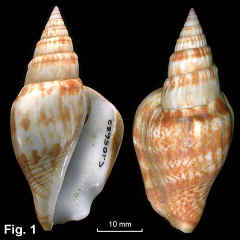|
|
|
|
|
Strombus campbelli Griffith & Pidgeon, 1834 Description: Shell with spire tall, lip flared. Spire whorls with axial ribs, sometimes restricted to earliest whorls, and a single, narrow, spiral groove at top fifth of whorls. Body whorl concave below suture, with large nodule on dorsal surface, preceded by axial folds; ventral surface smooth, somewhat flattened. Base with about a dozen spiral cords. Columella with smooth callus, swollen centrally. Outer lip flared, extending upwards onto previous whorl, with weak, short lirae on lower half internally. Stromboid and posterior notches wide and shallow. Colour white with tan spiral bands of axial zigzags and flecks; aperture and callus white. Operculum corneous, long, thin, serrated. Periostracum thin, smooth, translucent yellow. Size: Up to 68 mm in length. Distribution: Endemic to Australia; Houtman Abrolhos, WA, around northern Australia, to Clarence River, NSW. Habitat: Intertidal and shallow subtidal. Comparison: Abbott (1960) regarded this species as a subspecies of the widespread tropical Indo-West Pacific species Strombus vittatus Linnaeus, 1758. However, both S. campbelli and S. vittatus occur together in Queensland, and are quite distinct. S. vittatus is distinguished by a taller spire, the last two or three spire whorls smooth, the nodule on the dorsal side of the last whorl weak or absent, and no axial folds on the ventral surface of the last whorl. S. vittatus is known from NSW from only one fossil specimen (see Coverage in family introduction). Fig. 1: Off Tweed Heads, NSW, in 55 m (C.105632) |
